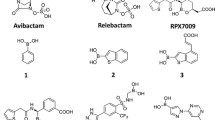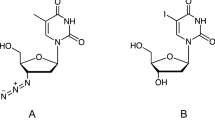Abstract
Antibiotic-resistant penicillin binding protein (PBPs) production is one of the reasons why bacteria develop resistance to β-lactam antibiotics, and this needs to be tackled in the continual battle to produce effective antibiotics. The transition state analogue of boronic acid inhibitors mimicking the structures and interactions of good penicillin substrates are known to be potent β-lactamase inhibitors. We have recently identified boronic acids as a selective scaffold for Actinomadura sp. strain R39 DD-peptidase (PBP). Here, we report the synthesis and biological evaluation of a comprehensive set of 16 boronic acid analogues and establish their structure–activity relationships as well as their potential for use as PBP inhibitors. The docking studies of all the synthesized compounds were carried out in Molegro Virtual Docker. Of the 16 compounds synthesized, compound 8e exhibits the highest binding affinity (187.5 kcal/mol) followed by compounds 8f, 8d, 8a, 8g, 8c and 8i. The minimum inhibitory concentration (MIC) of all the 16 synthesised compounds 6a–6f, 8a–8i, 10 and 11 were tested against two Gram-positive (S. aureus, and S. pyogene) and eight Gram-negative (E. coli, C. koseri, K. oxytoca, K. pneumoniae, S. dysentriae, S. typhi, C. fruendi, and P. aeruginosa) bacteria. The biological evaluation of the synthesized boronic acid analogues were found to be effective in all cases, although it is more pronounced for pyrazine-containing dipeptidyl boronic acid (8e, MIC = 0.062 mg/ml) and hence considered as an effective inhibitor, thereby highlighting the importance of phenylalanine as linker and heterocyclic aromatic carboxylic acid as terminal moieties. This study exemplifies that pyrazine-containing dipeptidyl boronic acid (8e) as a PBP inhibitor could open up new avenues in the development of PBP-inhibiting molecules that eventually display bactericidal effects on distinct bacterial species.








Similar content being viewed by others
Abbreviations
- EDC.HCl:
-
1-Ethyl-3-(3-dimethylaminopropyl) carbodiimide hydrochloride
- DIPEA:
-
N,N-diisopropylethylamine
- HOBt:
-
Hydroxy benzotriazole
- MBC:
-
Minimum bactericidal concentration
- MIC:
-
Minimum inhibitory concentration
- TFA:
-
Trifloroacetic acid
References
D.G. Hall, in Boronic acids: preparation and applications in organic synthesis and medicine (Wiley, Weinheim, 2006). doi:10.1002/3527606548.ch1
A. Patricia, Clin. Microbiol. Rev. 14, 933 (2001)
S.M. Drawz, R.A. Bonomo, Clin. Microbiol. Rev. 23, 160 (2010)
J. Adams, M. Kauffman, Cancer Invest. 22, 204 (2004)
R.F. Barth, J.A. Coderre, M.G. Vicente, T.E. Blue, Clin. Cancer Res. 11, 3987 (2005)
M.P. Groziak, Am. J. Ther. 8, 321 (2001)
M.C. Davis, S.G. Franzblau, A.R. Martin, Bioorg. Med. Chem. Lett. 8, 843 (1998)
P.D. Robinson, M.P. Gorziak, Acta Crystallogr. C55, 1701 (1999)
L.M. Brunet, M.D. Bailey, G. Bolger, J. Med. Chem. 47, 1605 (2004)
L.A. Miller, K. Ratnam, D.J. Payne, Curr. Opin. Pharcol. 1, 451 (2001)
T.I. Lazarova, L. Jin, M. RynKiewicz, Bioorg. Med. Chem. Lett. 16, 5022 (2006)
B. Gallwitz, Drugs Today 43, 801 (2007)
S.G. Dastidar, D. Rajagopal, A. Ray, Curr. Opin. Investig. Drugs 8, 364 (2007)
Z. Astrid, B. André, H. Alexandre, A. Ana, J. Bernard, S. Eric, C. Paulette, L. André, Bioorg. Med. Chem. 20, 3915 (2012)
I.E. Crompton, B.K. Cuthbert, G. Lowe, S.G. Waley, Biochem. J. 251, 453 (1988)
C.J. Burns, R. Goswami, R.W. Jackson, T. Lessen, W. Li, D. Pevear, P.K. Tirunahari, H. Xu, U.S. Patent WO 2010130708 A1 (2010)
S. Ness, R. Martin, A.M. Kindler, M. Paetzel, M. Gold, S.E. Jensen, J.B. Jones, N.J.C. Strynadka, Biochemistry 39, 5312 (2000)
J.B. Patel, R. Franklin et al., in Performance standards for antimicrobial susceptibility testing; twenty-fifth informational supplement, vol. 35 (Clinical and Laboratory Standards Institute, Wayne, 2013)
S.P. Thomas, R.M. French, V. Jheengut, V.K. Aggarwal, Chem. Rec. 9, 24 (2009)
Acknowledgements
The authors sincerely acknowledge the support provided by Chemical Research Division, Ranbaxy Labs limited, Gurgaon, for carrying out experiments at their research center. We thank GITAM University for providing Biological activity data. We also acknowledge Prof. Nittala S. Sarma CSIR Emeritus Scientist and Principal Investigator, INCOIS Project PNCO Department, School of Chemistry, Andhra University, Visakhapatnam, for helping us in English language correction of the manuscript.
Author information
Authors and Affiliations
Corresponding author
Electronic supplementary material
Below is the link to the electronic supplementary material.
Rights and permissions
About this article
Cite this article
Venugopal, D.V.R., Karteek Rao, A., Uma Devi, P. et al. Design, synthesis and characterization of peptidyl boronate analogues as effective antimicrobial agents. Res Chem Intermed 43, 5755–5778 (2017). https://doi.org/10.1007/s11164-017-2961-0
Received:
Accepted:
Published:
Issue Date:
DOI: https://doi.org/10.1007/s11164-017-2961-0




